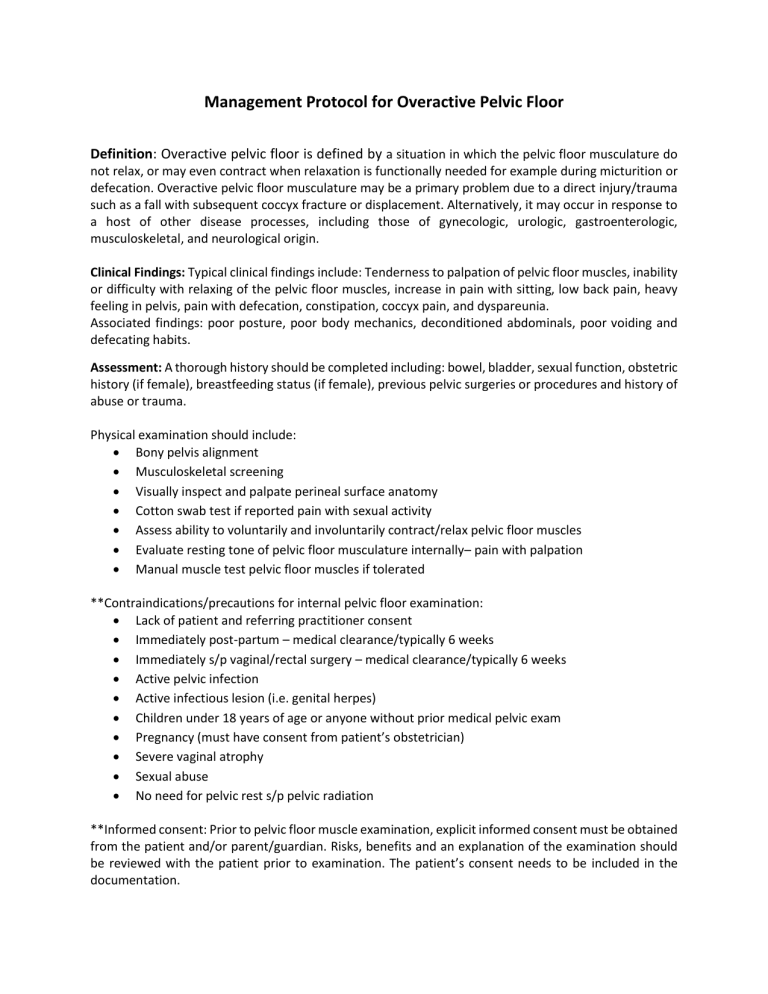
Management Protocol for Overactive Pelvic Floor
Definition: Overactive pelvic floor is defined by a situation in which the pelvic floor musculature do
not relax, or may even contract when relaxation is functionally needed for example during micturition or
defecation. Overactive pelvic floor musculature may be a primary problem due to a direct injury/trauma
such as a fall with subsequent coccyx fracture or displacement. Alternatively, it may occur in response to
a host of other disease processes, including those of gynecologic, urologic, gastroenterologic,
musculoskeletal, and neurological origin.
Clinical Findings: Typical clinical findings include: Tenderness to palpation of pelvic floor muscles, inability
or difficulty with relaxing of the pelvic floor muscles, increase in pain with sitting, low back pain, heavy
feeling in pelvis, pain with defecation, constipation, coccyx pain, and dyspareunia.
Associated findings: poor posture, poor body mechanics, deconditioned abdominals, poor voiding and
defecating habits.
Assessment: A thorough history should be completed including: bowel, bladder, sexual function, obstetric
history (if female), breastfeeding status (if female), previous pelvic surgeries or procedures and history of
abuse or trauma.
Physical examination should include:
Bony pelvis alignment
Musculoskeletal screening
Visually inspect and palpate perineal surface anatomy
Cotton swab test if reported pain with sexual activity
Assess ability to voluntarily and involuntarily contract/relax pelvic floor muscles
Evaluate resting tone of pelvic floor musculature internally– pain with palpation
Manual muscle test pelvic floor muscles if tolerated
**Contraindications/precautions for internal pelvic floor examination:
Lack of patient and referring practitioner consent
Immediately post-partum – medical clearance/typically 6 weeks
Immediately s/p vaginal/rectal surgery – medical clearance/typically 6 weeks
Active pelvic infection
Active infectious lesion (i.e. genital herpes)
Children under 18 years of age or anyone without prior medical pelvic exam
Pregnancy (must have consent from patient’s obstetrician)
Severe vaginal atrophy
Sexual abuse
No need for pelvic rest s/p pelvic radiation
**Informed consent: Prior to pelvic floor muscle examination, explicit informed consent must be obtained
from the patient and/or parent/guardian. Risks, benefits and an explanation of the examination should
be reviewed with the patient prior to examination. The patient’s consent needs to be included in the
documentation.
Differential Diagnosis:
Infection
GI disorders
Lumbopelvic cancers
Urologic disorders
Gynecological disorders
Dermatological disorders
Sexual injury
Lumbar spine dysfunction
Sacral dysfunction
Hip pathology (labral tears)
Nerve entrapments
Recommended Outcome Tools:
Patient Specific Functional Scale
Vulvar questionnaire
Pelvic Floor Distress Inventory-20 (PFDI-20) and Pelvic Floor Impact Questionnaire-7 (PFIQ-7)
Marinoff scale
Bristol stool scale
NIH-Chronic Prostatitis Symptom Index (NIH-CPSI)
Goals:
Decrease pain
Normalize bowel/bladder/sexual function
Able to tolerate sitting, as needed for work or home tasks
Able to tolerate annual health/pelvic examination, tampon insertion, intimacy
Decrease PFDI-20 score by 15%
Decrease PFIQ-7 score by 7%
Independence in home exercise program
Frequency and Duration: This will vary depending on the patient’s needs. A general rule of thumb is 410 physical therapy sessions, up to 3 months
Discharge Planning: Patients can expect to learn self-management strategies, have a customized home
exercise program, and have improved function during work, recreation, activities of daily living, or
exercise during the episode of care.
Management Protocol for Underactive Pelvic Floor
Definition: A situation in which the pelvic floor muscles cannot voluntarily contract when this is
appropriate. Underactive pelvic floor musculature may be a primary problem due to congenital factors
(anatomical variants, bladder exstrophy). Alternatively, it may occur in response to collagen defects,
chronically raised intra-abdominal pressures, estrogen deficit, childbirth, trauma, denervation or
following a pelvic surgery.
Clinical Findings: Typical clinical findings include core and pelvic floor muscle weakness.
Associated findings: poor posture, poor body mechanics, deconditioned abdominals, lower back pain,
balance deficits, fecal incontinence, urinary incontinence, pelvic organ prolapse, dyspareunia and/or
sexual dysfunction.
Assessment: A thorough history should be completed including: bowel, bladder, sexual function,
obstetric history (if female), breastfeeding status (if female), previous pelvic surgeries or procedures and
history of abuse or trauma.
Physical examination should include
Bony pelvis alignment
Musculoskeletal screening
Visually inspect and palpate perineal surface anatomy
Assess ability to voluntarily and involuntarily contract/relax pelvic floor muscles
Evaluate resting tone and/or tenderness of pelvic floor musculature internally
Manual muscle test pelvic floor muscles
**Contraindications/precautions for internal pelvic floor examination:
Lack of patient and referring practitioner consent
Immediately post-partum – medical clearance/typically 6 weeks
Immediately s/p vaginal/rectal surgery – medical clearance/typically 6 weeks
Active pelvic infection
Active infectious lesion (i.e. genital herpes)
Children under 18 years of age or anyone without prior medical pelvic exam
Pregnancy (must have consent from patient’s obstetrician)
Severe vaginal atrophy
Sexual abuse
**Informed consent: Prior to pelvic floor muscle examination, explicit informed consent must be obtained
from the patient and/or parent/guardian. Risks, benefits and an explanation of the examination should
be reviewed with the patient prior to examination. The patient’s consent needs to be included in the
documentation.
Differential Diagnosis:
Infection
GI disorders including stool impaction
Restricted mobility
Cognitive deficits
Atrophic urethritis/vaginitis – estrogen status
Pharmaceuticals
Excessive urine production - hyperglycemia
Urologic disorders
Gynecological disorders
Psychological disorders
Recommended Outcome Tools:
Patient Specific Functional Scale
Pelvic Floor Distress Inventory-20 (PFDI-20) and Pelvic Floor Impact Questionnaire-7 (PFIQ-7)
NIH-Chronic Prostatitis Symptom Index (NIH-CPSI)
Goals:
Improve strength
Normalize bowel/bladder/sexual function
Decrease NIH-CPSI score
Decrease PFDI-20 score by 15%
Decrease PFIQ-7 score by 7%
Independence in home exercise program
Frequency and Duration: This will vary depending on the patient’s needs. A general rule of thumb is 410 physical therapy sessions, up to 3 months 4.
Discharge Planning: Patients can expect to learn self-management strategies, have a customized home
exercise program, and have improved function during work, recreation, activities of daily living, or
exercise during the episode of care.
